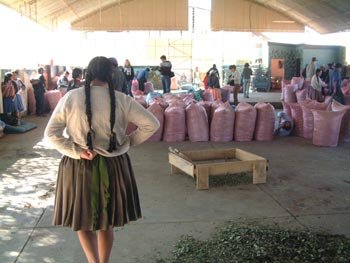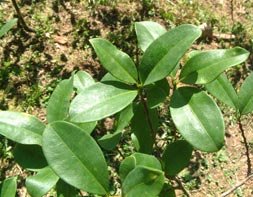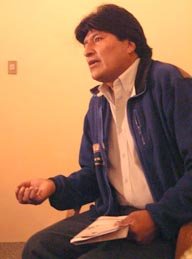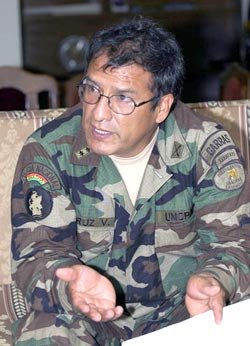


Bolivian Drug War Myths Fall Apart
After Years of Struggle, the Government Recognizes Legitimate, Legal Coca Cultivation in the Chapare
By Alex Contreras Baspineiro
Narco News South American Bureau Chief
October 7, 2004
COCHABAMBA, BOLIVIA: One of the greatest myths of the drug war in Bolivia has fallen to pieces in the last few days. The Carlos Mesa administration and the U.S. embassy in this country have recognized the existence of 3,200 hectares (7900 acres) of coca, grown for traditional, personal consumption, in the Chapare region, near the city of Cochabamba.
 A legal coca market in the Chapare Photo: Gerardo Rojas D.R. 2004 |
On October 3, the government and the coca growers signed a nine-point Memorandum of Understanding to pacify, conditionally, the “red zone” here in the Chapare. The Chapare is located in a region known as the Tropic of Cochabamba.
One year ago, U.S. Ambasador David Greenlee said: “The Tropic of Cochabamba has only one path: to continue to expand the planting of alternative development crops in the region, and to maintain the eradications until we reach ‘zero coca.’” (ANF, October 27, 2003)
Today, point four of the new agreement reads: “the reduction of all coca crops the Tropic of Cochabamba to no less than 3,200 hectares is agreed upon, until the results of the Study of the Demand for Legal Coca Consumption are known.” According to the agreement, this land will be divided between the members of the Six Federations of the Tropic of Cochabamba, the main coca growers’ federation.
 Photo: Gerardo Rojas D.R. 2004 |
“There is joy throughout the Chapare, because if we calculate it, this allows every coca-growing family one cato of coca. This is the product of many years of struggle with previous governments, who were subject to the will of the United States Embassy,” said Bolivian congressman and coca growers’ leader Evo Morales.
A cato is 1,600 square meters, just over a third of an acre.
The situation is only temporary, and will be revised upon completion of a new independent survey on production and consumption patterns. However, Morales said that this agreement with the government has essentially broken Law 1008, the Bolivian “Regulation of Coca and Controlled Substances Law” that has been in effect since 1988, and that the coca growers have been trying to change ever since.
A Little History
On September 28, a confrontation between coca growers in the town of Bustillos and soldiers from the Joint Task Force, the military’s major anti-drug squad, resulted in the death of farmer Juan Choque Cruz. Choque Cruz, 38, was shot in the head and killed instantly by a uniformed soldier, while nineteen others were wounded.
 Evo Morales Photo: Gerardo Rojas D.R. 2004 |
The murder, yet to be explained by the government, provoked a strong reaction from the coca growers’ movement. Thousands surrounded military outposts and blocked the entrances to their own communities. The government had no choice but to halt forced eradication in the region.
Now, the elimination of coca fields will be voluntary, and organized by the Six Federations of the Tropic of Cochabamba.
Law 1008, passed on July 19, 1988 and often derided as “draconian,” outlines three coca production zones in Bolivia: “traditional” coca, “excess and transition” coca, and illicit coca.
The traditional zone is defined as the area where, according to the government, coca has been grown historically and for traditional purposes. The excess and transition zone comprises coca planted in marginal areas by settlers, and the illicit zone comprises the rest of the country. The Tropic of Cochabamba contains a mixture of all three zones, so while some coca is already produced legally, much is also targeted for eradication.
The coca growers say that current Interior Minister Saul Lara, once a legal adviser to coca growers’ organizations, was one of the authors of the now-weakened Law 1008.
Throughout these years of struggle, the coca growers have proposed to several administrations a pause in eradication, recognition for a certain amount of coca, or legalization. No one ever listened to them.
Since the implementation of Law 1008, more than 115 people are estimated to have been killed. Most of them have been coca growers, while a minority were soldiers. Not one of the murders has been brought to justice; the military operates with total impunity.
A Difficult Future
Before signing the Memorandum of Understanding, government representatives made a series of consultations and phone calls to the United States Embassy, said one coca grower who was present at the negotiations.
The government, for its part, also claimed victory after meeting with coca growers. Interior Minister Lara assured the media that the agreement did not, in fact, invalidate Law 1008. On the contrary, he said, it will help achieve the goal of eradicating 8,000 hectares (20,000 acres) of coca by the end of the year.
“We have no doubt that the United States Embassy and the international community understand that this is a move to comply with international efforts,” said Lara. “We are using our own sovereign law in a peaceful manner, working in consensus with the coca growers’ leadership.”
The United States Embassy believes that the new agreement is a continuation of the existing coca eradication, and that while 3,200 hectares will be recognized for one year, they are not actually legalized.
 Colonel Jaime Cruz Vera Photo: Jeremy Bigwood D.R. 2004 |
Colonel Jaime Cruz Vera of the Mobile Rural Patrol Unit (UMOPAR) told Narco News on August 4: “We can say that the entire Chapare zone is a cocaine factory. Today we count between five and seven thousand hectares, more or less, of coca, of which ninety-nine percent goes to the fabrication of cocaine. The coca leaf is not used here for traditional uses, usually the people chew coca from Los Yungas, even here in the towns. A few of the settlers here chew their own coca, but that’s minimal.”
U.S. Ambassador David Greenlee has also said, since his arrival in Bolivia in January 2003, that the U.S. administration did not support any pause in the eradication, but rather supported the “zero coca” policy (La Prensa, January 18, 2003).
Evo Morales said that the legal recognition of coca crops in the Chapare, although temporary, “is a historic victory because it lays bear the fallacies of the drug war imposed by the empire.”
The agreement between the government and coca farmers is signed at a crucial time for Bolivia. This month marks one year since the “gas war.” A series of mobilizations has been announced, including a massive march on La Paz. Yesterday the government began to draft a new Hydrocarbons Law, which looks to place the industrialization of the country’s gas into the hands of multinational corporations. Carlos Mesa has even threatened to leave the government if popular demands and the clamor of the people try to impose their will once again.
Memorandum of Understanding
The agreement signed by the government and the coca growers of the Tropic of Cochabamba contains the following points:
- The government promises to compensate the family of the man killed, and to compensate those injured for their medical expenses, as a result of the confrontations in the Tropic of Cochabamba.
- The government and the coca producers of the Tropic of Cochabamba ratify the decision to respect and coordinate all actions involving interdiction and the fight against narco-trafficking.
- The government and the coca producers ratify a commitment to immediately carry out a Study of the Demand for Legal Coca Consumption, which will be managed by a national and/or international institution, and whose results must be recognized no less than one year from the signing of this memorandum.
- The reduction of all coca crops the Tropic of Cochabamba to no less than 3,200 hectares is agreed upon, until the results of the Study of the Demand for Legal Coca Consumption are known.
- This area for coca cultivation will be distributed among the 23,000 members of the Six federations, including the settled area of the Isiboro Sécure National Park.
- It is agreed that the coca in the national parks of Isiboro Sécure and Carrasco will be completely reduced. In the specific case of Carrasco National Park, the government will contact competent organizations (SERNAP, municipal federations, and others) to reach a consensus on a demarcation line.
- The process of reduction and registration will be peaceful. It will be executed, controlled and supervised by DIRECO and the Joint Task Force, coordinating with the Six Federations of the Tropic of Cochabamba.
- The coca growers agree to suspend all pressure tactics against the Joint Task Force and alternative development programs immediately.
Lea Ud. el Artículo en Español
- The Fund for Authentic Journalism
For more Narco News, click here.




